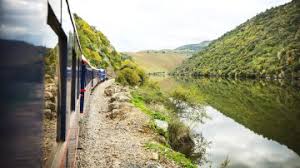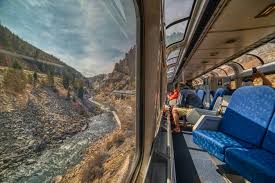I’ve found Portugal’s ultimate train trip — and it just takes one day

Set amid the Douro Valley, the new Comboio Presidencial combines fine dining, great wines, a visit to a port-making quinta — and no small amount of nostalgia
On a recent Saturday morning I was up early, skipping a damn good breakfast at the Casa da Companhia hotel in central Porto and running through a deluge to the city’s main Sao Bento railway station to catch the maiden voyage of the relaunched Comboio Presidencial train. A luxury addition to the Portuguese railways, the Presidencial features a new fine-dining experience as it follows the Douro line, which runs east for some 120 miles from Porto alongside the river.

It crosses increasingly rural landscapes all the way to Pocinho, a village on a shim of land among the vineyards and orchards of the upper river. The schedule promised a late-morning start, a meal of some three hours, a stop-off to tour the Quinta de Vargellas — the vineyard that supplies Taylor’s Port with its grapes — and a return to Porto by 10pm. It is a fine day trip to fit into any larger journey to Portugal, or a short break in the city.
At first sight, the Presidencial’s regal dark blue was a considerable improvement on the despondent grey of the regular rolling stock. The platform was a milling crowd of Presidencial travellers in smart-casual clothing, photo-snapping trainspotters and nosey parkers, TV reporters and documentary crews, and the train staff, who were unfortunately dressed in ashen grey uniforms and absurd half-bowler, half-fedora headgear.
It was a little after 9am when I boarded and already a throng of guests were milling about with glasses of port and wine (red, white and rosé from a single vineyard — in our case Ventozelo, although it changes each week). I took a glass and made a quick stroll through the train past wood-panelled seating compartments, past a Texan couple clutching their little tulip glasses of port (“Now, that there’s a mighty lovely red” and “How did you say it? Obri-gada?”), and finally to the dining cars, trim and crystalline with pastel bouquets on each table.
In Portugal you are fed nostalgia, paired with a glass of corked tradition, almost everywhere you go. Saudade, the Portuguese word for incomprehensible angst, has been levered into a national state of being, accompanied by mournful fado music and a backwards glance at the atlas of 1494, when Portugal dominated half the known world.
While I take issue with nostalgia’s muslin-eyed belief that better times are behind us, that civility lies in the past, it can occasionally kick up something interesting. Luxury trains, for instance — slow and august, they are as soaked in tradition as an olive in brine, arriving today from some indefinite golden era of travel when dressing for dinner was the rule.
There is no disguising the dream of the Presidencial. It wants to be a time machine. It was built in 1890 and was the official locomotion of Portuguese heads of state until 1970: monarchs until 1910, a dozen years of unstable republicans, and then, from 1922, members of Salazar’s Estado Novo dictatorship. Kings and autocrats are testy topics in Portugal, especially this year, the 50th anniversary of the Carnation Revolution, when the dictatorship was finally routed. Never mind that. This was Portuguese legacy at its most sentimental: the original brass fittings were polished, the drop chute toilets were a lesson in fluid dynamics, the scallop-backed green and pink furnishings were from the same Portuguese upholsterer that makes chairs for the Pope. Put your nose close to the wood panels and you could smell the embedded smoke of ten million cigarettes.
Earlier I said “maiden voyage” but this was not the first iteration of the Presidencial. A previous version, which ran between 2017 and 2022, featured a similar itinerary: a day-long return trip along the Douro capped by a stop at a vineyard, fortified by “gourmet lunch and wine harmonisation” created by a rotation of awarded and fêted international chefs.
This time the food was a 12-course set menu overseen by Chakall, the mononymous Argentine chef, a celebrity in Portugal, who is interested in bringing good, accessible food to everyone — a kind of Latin American Jamie Oliver. It was his name on the wine glasses, his name emblazoned on the menu card that lay resting at each table setting, and the man himself appeared from the kitchen car in his trademark turban to greet guests.
The idea was to eat our way along the river, starting in Porto and ending at the Vargellas vineyard. As we rolled out of Sao Bento station we started with the Bye Bye Francesinha, a “reinterpretation”, the menu said, of Porto’s signature sandwich. It was a reinterpretation in magnitude only, being the size of a Rubik’s cube rather than the usual Oxford English Dictionary. Still, the layers of beef, sausage, ham and cheese, covered in a beery tomato sauce, were just as they are in the best Portuense tascas: plump, hearty, warming.
Wine aside, the traditional food of northern Portugal doesn’t translate well into what we think of as fine dining. It is neither finicky nor light, and rests largely on eggs, chips, minute steak and lager. It is simple, filling working-class food. While there is some fuss made about fish (the octopus houses of Matosinhos are the best in the country), natives of Porto are affectionately known as tripeiros, or tripe-eaters, for a reason: there is plenty of blood, hoofs, tongues and gizzards to be ordered in the city. Though not on the Presidencial, where the only peaky dish was the beef tartare, which arrived at the same time as we passed into the mosaic of Douran vineyards. It was as green and cloudy as the tea terraces of the equator — the countryside, not the tartare, which was a pink teardrop served on a grilled cabbage leaf.
It was still raining, the water streaming across the windows like migrating silkworms. We were passing crumbling stone buildings with gardens growing on their walls. At each station men with clumsy thumbs struggled to take a picture before we rolled away. I was sharing the table with the TV crew and a few Portuguese writers. As the trip wore on, formality gave way to familiarity. They asked me to list all the curse words I knew in Portuguese. The reporter, who was with the Lisbon-based Benfica TV, admitted her nervousness about dispatching from Porto; the Porto-Benfica football club rivalry runs deep, and she was behind enemy lines. Some remarked on the fact there was no wi-fi on board (there are no plans to add it). We all had more wine.
While we ate, two violinists made their way from car to car, playing a series of pop and show tunes. They were presumably meant to buttress the luxury but instead, with their matching pistachio-green gowns and mix of Coldplay, Miley Cyrus and Guns N’ Roses, they actively undermined it, spurring on furious beckoning of the waiter, who rushed around the compartment with two bottles in his hands.
Four hours after leaving Porto we arrived at Vargellas under a brief interlude of sun. With cold cans of Taylor’s Chip Dry and Tonic, we made our whirlwind tour of the grounds, which took in a bit of grape stomping, a bit of bottle tonging (a unique way of opening bottles with heated tongs) and a bit of port sniffing, before being shuffled back onto the train as the deluge began again.
The return journey was spent in a kind of stupor. The wine still flowed freely but the food was limited to leftover bread and a few plates of cured meat. I’d expected a full meal on the return journey as well, something that wasn’t priggish gluttony but economics. At £635 a ticket for the day — the average bi-monthly pay cheque in Portugal, or a month’s rent for a studio apartment in Porto — you’d expect to be fed a little more than 12 small plates.
Some bumps are expected on an inaugural journey. When I ran into Chakall a few days later at his Nortada gastropub in Porto, he mentioned that he had tweaked the menu on the train, shifting it around, working on the timing and generally smoothing out the journey.
And the food had been good — eating the next night at the Casa da Companhia hotel (a quiet block of refinement in the busy Ribeira district), I couldn’t help but compare the seafood rice and the alheira (a Portuguese sausage) before me to those I’d had on the train. Both were excellent but there was something about the moving scene beyond the train window — the often tropical lushness of the Douro Valley — that elevated the meal and gave it a panache that the crowds milling along Rua das Flores could not match. But that is the nature of nostalgia — a work of memory, it is always unrivalled.
The spring voyage of the Presidencial was an experiment and it will return to the rails in September. In the meantime, the regular Douro Line trains between Porto and Pocinho run several times per day and are considerably cheaper (returns from £25pp, cp.pt/passageiros/en). The £610 you save could buy an awful lot of vinho, which you’re free to take on the train with you, a journey of three and a half hours each way. And you’d still have plenty left over to try one of Chakall’s Porto restaurants — Zapata, a Mexican joint (mains from £12; @zapatabychakall on Insta), or Nortada, a gastropub with pizza and pub fare (mains from £9; cervejanortada.pt).
As we graced the outskirts of Porto, the Texas matron sidled into the chair beside me. “I figured you’re the one to ask,” she said, her face at a conspiratorial distance from mine. “We’ve already spent a considerable sum but do we … leave a tip?” No, I told them. Portugal is far too civilised for that.
JR Patterson was a guest of Comboio Presidencial, which has returns from £635pp, including a 12-course meal and drinks, visit to Quinta de Vargellas, and port wine tasting (comboiopresidencial.pt); and of Casa da Companhia, which has B&B doubles from £180 (casadacompanhia.com). The next departures are in September. Fly to Porto
Onboard catering rarely gets the pulse racing on the British railway network — though an honourable exception must be made for the club car of the Caledonian Sleeper. No fewer than seven single malt whiskies are on hand here, meaning northbound passengers from Euston get a peaty foretaste of the Scottish landscapes in which they will awake. Sharp Highland air is the antidote to hangovers once you disembark, particularly if you happen to alight in Inverness, poised for monster-sized adventures within the Great Glen. Explore on a RailBookers city break there, which features an excursion to Loch Ness, a hop-on, hop-off city bus tour, three nights at a Mercure hotel and sleeper trains both ways from London.
If you’ve ever fancied starring in your own ITV drama, step aboard one of the Belmond British Pullman’s “murder mystery” departures from London Victoria. The interactive event sees characters strolling the aisles dropping clues of murderous intent — passengers can raise their eyebrows in the pauses during their five-course lunch. The murder isn’t real but the Pullman carriages are, and they date to the 1950s, with polished wooden panelling and plush fabrics aplenty. After returning to the capital, stay at the Clermont, London’s first station hotel, in a grand grade II listed building with all the sites of west London within easy reach.
Details Returns from £535pp, including lunch and drinks (belmond.com). B&B doubles from £246 (theclermont.co.uk)
While the HS2 saga grinds along at snail’s pace, a web of high-speed lines already proliferates across the Continent, with France and Spain claiming light-speed networks. It’s a thrill to ride them, a must-have experience for rail travel fans. Ride both as part of an odyssey bound for the Spanish capital, beginning by catching a Eurostar service from St Pancras to Paris before changing for a TGV that glides beside the Rhône at speeds nudging 200mph. After exploring Barcelona, take a Madrid-bound “Pato” train — so nicknamed because its front looks a bit like a duck — which is capable of speeds that would turn a mallard to confit. On this self-guided trip you’ll spend two nights in Barcelona, three in Madrid, all in central hotels.
Details Seven nights’ B&B from £1,495pp, including rail travel (ffestiniogtravel.com)
The latest in a line of trains bearing the moniker Orient Express, Accor’s La Dolce Vita Orient Express is an Italian luxury service that (from next year) will roam everywhere from the green plains of the Po to the foothills of Etna. Just as handsome as the views are the interiors, which are cinematically styled with mirrored surfaces and brass light fittings. Book on to one of its Sicilian itineraries, connecting the boisterous capital of Palermo with the clifftop splendour of Taormina, with a night spent in a private cabin, and gastronomic and historical excursions in both cities. In Taormina, the Villa Chiarenza B&B is a baroque villa built in the 1700s with elegant rooms, while in Palermo try the three-star Hotel Palermo Quattro Canti with a roof terrace and light airy rooms overlooking the city.





